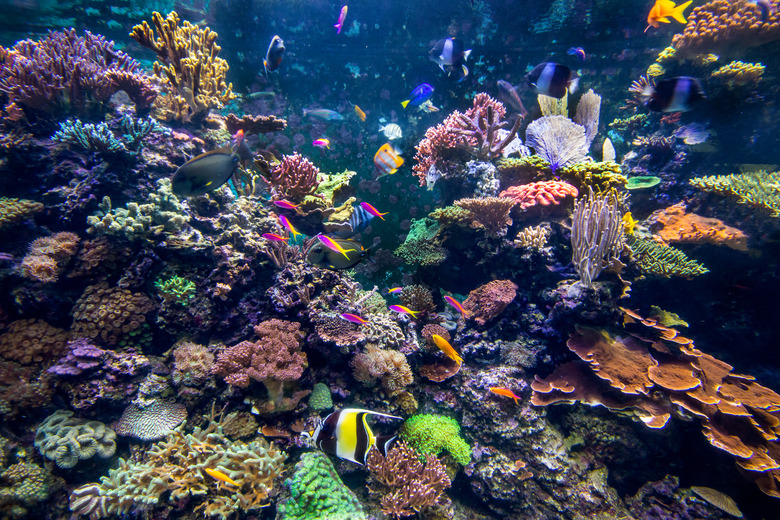Weather Of Coral Reefs
Corals are colonies of connected individual polyps with symbiotic zooxanthellae algae that live in the polyps. The polyps secrete a calcium carbonate exoskeleton that is the structure that builds the coral reef.
Corals are vital ecosystem engineers. They create habitat for other species to live in, a shelter for animals to hide and nursery grounds for juveniles.
Types of Corals
Types of Corals
There are three main types of coral: stony or hard coral, soft coral and deep-sea coral. Hard corals are the species that build reefs, while soft corals include such as sea whips and sea fans.
There are around 800 species of hard corals, 1288 reported soft coral species and over 3,300 species of deep-sea corals around the world.
Types of Reefs
Types of Reefs
All types of coral reefs provide habitat for thousands of marine fish and invertebrates. There are three main types of coral reefs:
- The first are called fringing reefs, which are built from rocky coasts.
- The second are called barrier reefs which grow on the outer seaward edge with lagoons between the reefs and the coast. One of the most famous is the Great Barrier Reef in Australia.
- The third are atolls which are encircle a lagoon and are not near dry land.
Coral Reef Locations
Coral Reef Locations
Coral reef locations are primarily in shallow tropical and subtropical waters between 30 degrees north and 30 degrees south of the equator. 90 percent of the world's reef systems occur in the Indo-West Pacific biographical region. The Great Barrier Reef off the coast of Australia is the world's biggest coral reef. The second largest coral reef lies off the Caribbean coast of Mexico and Belize.
Corals without zooxanthellae algae can also be found in oceans up to 20,000 feet (6,000 meters) deep around the world. These deep-sea corals do not have light to photosynthesize. As a result, they grow much more slowly. These deep-sea corals can be found on seamounts, which are peaks under the water.
Temperatures in Coral Reefs
Temperatures in Coral Reefs
The coral reef biome climate is tropical. Coral reef temperatures in the wild range from 68 to 97°F (20 to 36°C). The warm, shallow water is essential for photosynthesis of the zooxanthellae algae.
Deep-sea corals are capable of living in temperatures as low as 30.2°F (-1°C).
Coral Reef Weather Cycles
Coral Reef Weather Cycles
The tropical weather in coral reefs is prone to periodic storms and cyclones. Pressure from large waves and massive inputs of freshwater and sediment from heavy rains can damage coral reefs. Coral reefs in the east-central Equatorial Pacific regions are also affected by the El Niño and La Niña weather patterns which cause changes in temperatures.
During El Niño, the relationship between the ocean and atmosphere causes a warming period. When the cycle switches to a La Niña period, temperatures drop below average. The El Niño and La Niña cycles are somewhat irregular and can last anywhere from 9 months to several years.
Cultivating Coral Reefs
Cultivating Coral Reefs
Due to problems with coral reefs dying around the world, conservationists often cultivate them in captivity to help them to grow. The reef tank temperature corals like best are similar to wild conditions. Reef aquariums should be kept as stable as possible between 72 to 80°F (22 to 27°C) but ideally closer to 74 to 78°F (23 to 25°C).
Coral conservationists are working to rebuild coral gardens through several methods. One method is to collect damaged corals that would otherwise die, then grow them in an artificial setting until they are big enough to transplant onto frames in the ocean.
Another way is to collect coral gametes during their annual spawning and rear them in an aquaculture setting before transplanting them back to the wild.
References
- Exploring the Environment: Coral Reefs
- Radford University: Coral Reefs
- Smithsonian: Corals and Coral Reefs
- NOAA: Coral Reef Ecosystems
- Coral Reef Research Foundation: Water Temperatures
- Geography Bulletin: Feature article: Coral Reefs: Environmental Change and Management
- Reefs Magazine: The Great Temperature Debate I
- NOAA: What are El Niño and La Niña?
- Smithsonian: Deep-Sea Corals
- ICRI: What Are Corals?
- Science Direct: Soft Corals
- Reef Doctor: Reef Restoration
Cite This Article
MLA
Jerrett, Adrianne. "Weather Of Coral Reefs" sciencing.com, https://www.sciencing.com/weather-coral-reefs-6911644/. 22 November 2019.
APA
Jerrett, Adrianne. (2019, November 22). Weather Of Coral Reefs. sciencing.com. Retrieved from https://www.sciencing.com/weather-coral-reefs-6911644/
Chicago
Jerrett, Adrianne. Weather Of Coral Reefs last modified March 24, 2022. https://www.sciencing.com/weather-coral-reefs-6911644/
